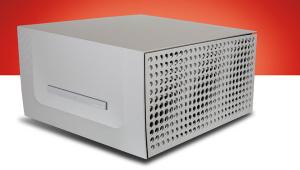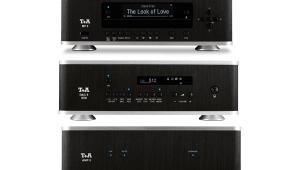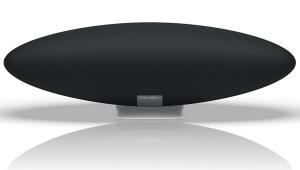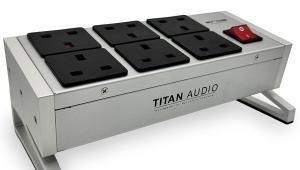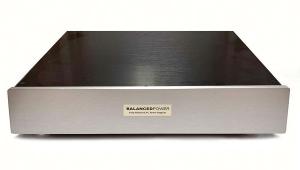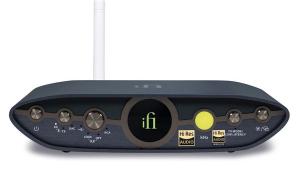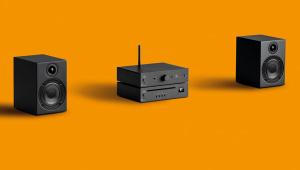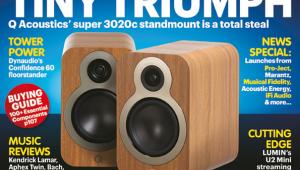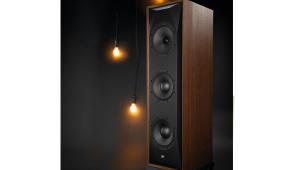Longdog Audio P6100M

 In these days of networked this and smart that, wireless something and Class D something else, Longdog Audio’s P6100M monoblock power amplifiers feel gloriously old fashioned. They make a sort of negative style statement that only a certain type of hardcore (or purist, as I’d prefer to call them) audiophile would consider. Count me in, because I’m the sort of person who gets more excited about 100W RMS per side of MOSFET power for £3,500, than I do about any number of smart devices sporting fancy digital signal processing.
In these days of networked this and smart that, wireless something and Class D something else, Longdog Audio’s P6100M monoblock power amplifiers feel gloriously old fashioned. They make a sort of negative style statement that only a certain type of hardcore (or purist, as I’d prefer to call them) audiophile would consider. Count me in, because I’m the sort of person who gets more excited about 100W RMS per side of MOSFET power for £3,500, than I do about any number of smart devices sporting fancy digital signal processing.
This, it must be said, is not wholly out of character for Nick Gorham of Longdog Audio. Nick’s no fan of fancy marketing and his products are unashamedly utilitarian in appearance, but – if my experience of his PSUs is typical – they’re about as good and rugged as it gets for the money.
“One of my goals was to make something that sounded like a good 2A3 direct heated triode valve amp in the midrange and treble, but with solid-state power in the bass”, the designer tells me. To this end, Nick has chosen special MOSFET power output devices to give a claimed 100W RMS per channel into 8ohm, and 190W into 4. Instead of using multiple arrays of output devices paralleled up to achieve the rated power output, the amps sport true single-die, high-power MOSFETs. These are run in complementary pairs to give a balanced output stage. Before this, a special driver stage feeds each of the two MOSFET output devices in each amp. These are small push-pull amplifiers; Nick says they’re: “Push (driven by Push, Pull), Pull (driven by Push, Pull) – so six Ps, which is why these amplifiers are called the P6”.
One particularly interesting aspect of the design is that it runs largely in Class A, thus – to a great extent – eliminating the switching distortion you get from conventional Class AB. Nick notes: “Each amplifier runs 400mA of bias current, and so is good for about 10 to 15W of Class A, before moving into B.” This means that, in most typical listening conditions, they’ll rarely ever get out of Class A – especially when using efficient loudspeakers.
The 100M part of the name refers to the fact that the original P6 was a 200W monoblock: “The parent that produced this offspring”; the 100M, is a downsized version. Still, Nick claims, this has a high damping factor, partly thanks to a large capacity power supply with help from: “As big a UK-wound transformer as we can fit in the case”. Non ferrous casework is used and extra care has been taken to manage thermal memory effects, he adds.
It’s a sturdy design through and through. The thick aluminium front panel contains a high-quality backlit metal on/off switch, above which is a gel name badge – a bit disappointing at this price. Round the back, you get good-quality binding posts for one set of loudspeakers, an IEC inlet for your power lead and RCA and XLR inputs for your signal cable; a small switch lets you toggle between the two inputs. There’s a choice of silver or black finishes. Things are generally done to a good standard, but the heatsinks are rather sharp, so I’d suggest you wear gloves when handling the units. Also, the cone-type feet are less than ideal; their pointy design allows good air circulation underneath the cases, but runs the risk of damaging any soft surfaces they might be resting on. The amplifiers do get quite hot after being switched on for a while, but not as toasty as some designs I’ve tried.
Sound quality
These are excellent-sounding monoblock power amplifiers that give a taste of truly exotic, high-end sound for much less money than you’d expect. They do three things especially well: firstly, they are more transparent than they have any right to be at this price. Secondly, there’s a fluid and mellifluous midband that’s distinctly un-solid-state in nature. And thirdly, all of these aforementioned attributes are backed up by a hefty punch, giving real load-driving abilities into difficult loudspeakers. Hi-fi veterans know that the third doesn’t necessarily follow the first two – indeed it rarely ever does.
After each of my two P6100Ms have a good hour or so warm up, I am struck by the clean and open sound. When driven by a Chord Hugo TT2 DAC (HFC 468) and Cyrus CD Xt Signature (HFC 386) silver disc transport, there is a stark difference between recordings. For example, Van Halen’s Jump sounds immensely powerful and engaging through my reference Yamaha NS-1000M loudspeaker, with the vocals and guitar riffs scorching out, EQ’d up to the max and compressed like only mid-eighties American rock can be. Yet when I move to Japan’s beautiful, lilting My New Career, I am struck by how soft and gentle it is. These monoblocks really do step aside in order to let the recording’s original flavour come flooding out.
This clarity is lovely to behold because you can focus in on the texture of the instruments, voices and, indeed, the studio. Many solid-state amplifiers have a slightly mushy, grainy feel, making everything sound quite drab and grey. Not so the P6100Ms; I am taken by the harmonics of the analogue synth sound running through Jump, and how the smooth – almost Bryan Ferry-styled – vocals of David Sylvian come over on the Japan track. You get a profound sense of ‘transformation’ as you switch tunes; for example, Randy Crawford’s sweet You Might Need Somebody sounds totally different to The Jam’s steely Kinks cover David Watts, while some amps occlude the stark contrast between these two very different recordings.
It’s not just the tone either; the P6100Ms really get into the groove of the music, recreating the shuffling rhythm of the music, whichever track you choose. Listening to Scooby Snacks by Fun Loving Criminals, I’m struck by how catchy the groove is. The amps also do impressively well with the phrasing of the vocals, which really adds life. These amps are toe-tappers, whatever music you care to play.
This is helped along somewhat by the naturally gutsy, barrel-chested sound, but it’s not thuggish or brutish in any way. There is enough slam to really tickle the big 12in bass drivers of my loudspeakers. This power is swiftly deployed; the opening drums on Roxy Music’s More Than This for example, are wonderfully powerful and dramatic when the wick is turned up. Yet still there’s no obvious sense of strain, despite the amplifiers not having a ‘muscle amp’ look about them.
Extended listening ends up with me thoroughly enjoying these Longdog Audio monoblocks. They’re really good at pretty much everything; for example, soundstaging is excellent, with a really ‘out of the box’ presentation that is never less than expansive and three dimensional. Ultimately, perhaps, they don’t have the true grit and insight of some really high-end designs – yet they deliver massive amounts of sound per pound.
Conclusion
Longdog Audio’s P6100Ms are one of those rare but happy hi-fi surprises. As a pair, you get a seriously high-end sound for mid-price money, one that has real strength in depth. If you can overlook the somewhat quirky styling and finish, and focus in on the music, you’ll surely agree that this is a great affordable audiophile bargain. DP
DETAILS
Product: Longdog Audio P6100M
Type: Monoblock power amplifiers
FEATURES
● Quoted power output: 100W RMS (8ohm)
● Quoted frequency response: 5Hz to 100kHz (+-1dB)
● Quoted signal-to-noise ratio: 92dB
 |
Inside this month's issue:
Ruark R610 music system and Sabre-R standmount speakers, PMC twenty.23i Active, floorstanders, English Acoustics Downton preamplifier, Bluesound NODE ICON preamp/streamer, Ortofon Concorde Music Blue MM cartridge and much, much more
|



